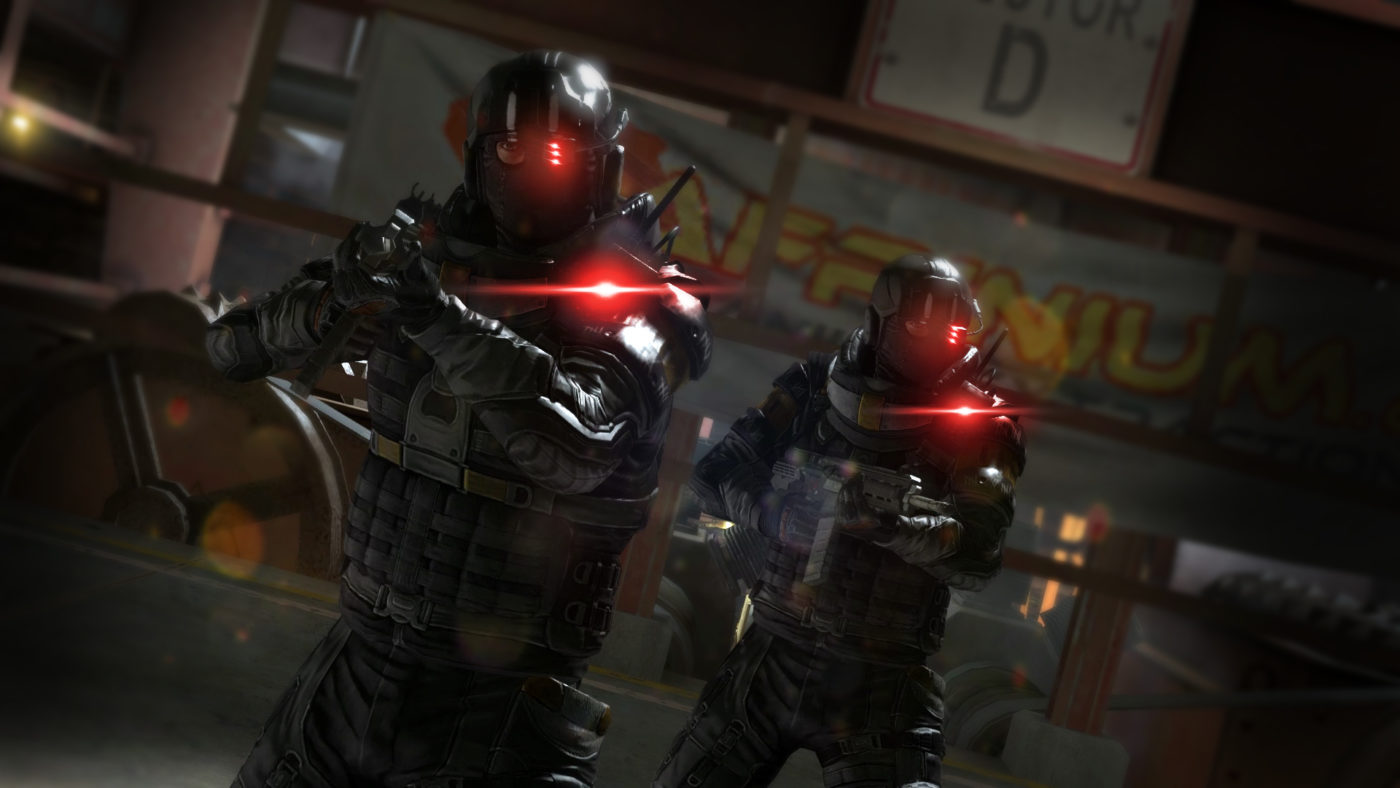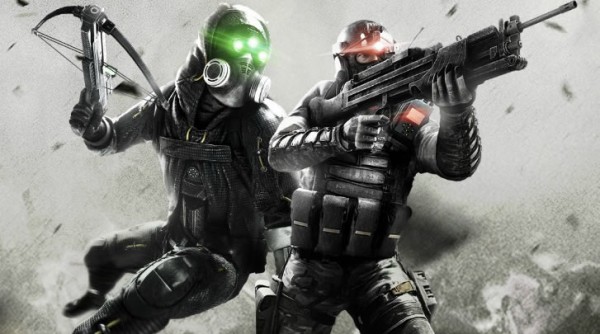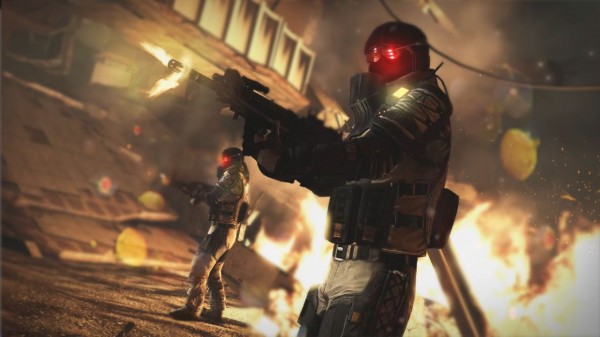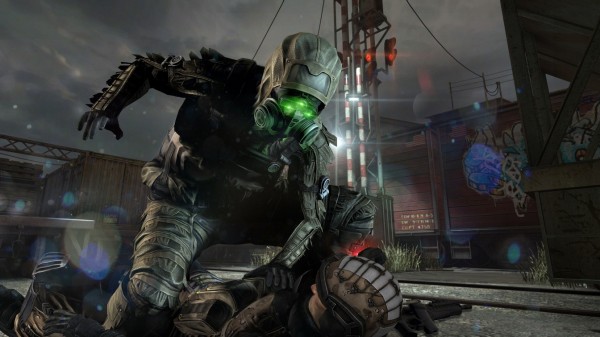Not seen since Splinter Cell: Pandora Tomorrow, Spies vs. Mercs makes a bold and ambitious return in Splinter Cell: Blacklist as a key competitive multiplayer component that stands out on its own as a deep and unique gameplay experience.
With it’s return comes not only the classic 2 vs. 2 SvM that gamers of old already know and love, but also a more contemporary take on the game type that is more in tune with today’s shooters and their focus on action-packed gameplay, higher player count and customization. While both offer uniquely different experiences in their own right, this outing of Spies vs. Mercs presents an experience unlike any other you’ll find in competitive multiplayer’s recent history.
Ubisoft also proves that competitive multiplayer can be balanced, even in SvM’s asymmetrical gameplay. While you’ll be hard-pressed to find any other online experience that is as satisfying, it’s a shame that the taste can be soured by shoddy visuals on the console, clumsy controls and frustrating connection issues.
But before we get into specifics, let me acquaint you with the Spies and Mercs of Splinter Cell: Blacklist.
Spies vs. Mercs
The balance and interplay between these two forces is a rather beautiful thing in Splinter Cell: Blacklist’s multiplayer. It’s not often that a developer can take such asymmetrical gameplay (first-person gameplay vs. third-person gameplay), throw it in a pot, and come out with a balanced finish.
As a Merc, you feel so completely out of control, yet powerful enough to deal with any unwanted situation that should arise. There is no time to plan – only react. As Spy, you may not possess the most effective killing gear, but you are in total control of the situation. You determine how the match will play out. It’s a game about wits, cunning and smarts as much as it is about teamwork and camaraderie.
The game is this: Mercenaries defend terminals and attempt to thwart attacks by eliminating Spies in the area of operation. Spies upload intel by hacking into terminals and remaining in the vicinity to see the process along. Within two 10-minute rounds, switching sides in between, two teams will fight over three terminals. The team that has captured the highest percentage of intel by the end of the match wins.
There are two variations; SvM Classic and SvM Blacklist.
SvM Classic
SvM Classic is what those who remember Pandora Tomorrow might be quite familiar with. Two Spies and two Mercs go at it in classically lit environments (very dark environments with little light), each with their own set loadouts.
Mercenaries are slow and lumbersome, but heavily armored and well-equipped individuals who must make due with a limited first-person field of view. They must rely heavily on their motion-sensing OpSuit, tactical flashlight, and arsenal of gadgets and weaponry like the frag grenade, proximity mine, VX gas grenade and resupply packs. They do pack quite a punch, however, with access to powerful assault rifles and shotguns.
Spies are fast and nimble agents who are able to slide, climb, and access areas of the map that a bulky Merc would have a hard time reaching. Using night vision goggles in a third-person, over-the-shoulder view, a stun crossbow and a deadly, one-hit takedown technique, Spies are the perfect hunters. However, getting caught in a firefight with a Merc must be avoided at all costs, as a short burst of bullets from a Merc’s assault rifle will take a Spy out in a mere seconds. To make up for their lack of ranged lethality, Spies also have access to gadgets like flashbangs, EMPs, smoke grenades and the signature sticky cam.
How each utilize the weapons, gadgets and abilities at their disposal is what separates the boys from the men. The same can be said regarding how each utilizes their surrounding and available light sources or shadows. It is in the Spies best interest to stick to the darkness while the Merc must utilize his flashlight sparingly in order to avoid giving his position away.
It’s a beautiful game of Cat and Mouse where Ubisoft was really able to capture and provide players with moments of pure suspense, tension and excitement. Call of Duty, this is no, but the slower-paced, tactical gameplay along with those moments of successful planning and proper execution are utterly satisfying and rewarding.
SvM Blacklist
Blacklist introduces a number of new gameplay elements to the SvM game, the most noticeable being in the way classes are set up.
In SvM Blacklist, matches are comprised of up to eight players; four Spies and four Mercs, each who can use currency earned in-game to unlock up to three preset loadouts, or three custom loadouts that you can tweak to your liking. The preset loadouts give you a bit of a trial run of all the unlocks before making any permanent decisions, so you may want to give them a try before going on any crazy spending sprees.
Each custom loadout consists of different options for your pistol, alternative weapon, vision modes, OpSuit abilities, and gadgets. Mercs run with vision options like motion tracker, ATS or RDF, OpSuit abilities like Adrenaline Suit, UAV Suit or Disruptor Suit, or gadgets like the frag frenade, VX gas grenade, intel device or proximity mine. They also have a wide range of powerful assault rifles or shotgun options at their disposal.
Unlike the Spy, a Merc’s vision is always on, each variation with their own unique properties. Adrenaline will increase field of view, vision quality, and movement speed while the UAV suit can deploy a reconnaissance UAV that will explode on command – very effective/annoying, depending on which side you’re on. The Disruptor Suit will mess with enemy electronics, rendering them useless while in range of an activated Disruptor Suit.
Spies, on the other hand, run with vision modes like thermal, sonar or EMF, OpSuit abilities like Intel Suit, Digital Ghillie Suit or Overcharge Suit, or gadgets like the EMP grenade, smoke grenade, flashbang or sticky camera.
The Spies’ vision modes all differ in effectiveness and range, usually sacrificing one for the other. The Intel Suit will tag all enemies in the vicinity for yourself and your teammates. The Digital Ghillie suit will act as a brief cloaking device that is most effective when at a stand still, while the Overcharge ability will send out a quick blast that will destroy all enemy equipment in the immediate area.
For both, there are also a number of OpSuit options including interchangeable helmets, goggles, gloves, and pants. Their properties essentially act as perks or specializations, granting you abilities like faster movement speed, quicker reloads or the ability to carry more than one gadget. On top of that, weapons can equip a number of different attachments that also carry unique properties while suit pieces can be customized with different camoflauge patterns.
In SvM Blacklist, you’ll notice that the different vision options play a large role in the gameplay and are really the differentiating factor between SvM Blacklist and SvM Classic. Spies are able to keep tabs on Mercs much more efficiently with the ability to track them through walls or other structures. However, the Mercs do benefit from brighter-lit maps, hence the lack of the flashlight attachment featured in the darker-lit SvM Classic maps.
This all leads to a much more accessible and replayable SvM experience that newcomers can get into quickly and where gamers can spend hours unlocking and playing with all the different loadout options.
Gameplay
In the end, while SvM Blacklist offers deeper customization and higher player counts in order to provide more content, more isn’t always better.
It’s a simple case of ‘the more stuff you have in your game the harder it is to balance’. While all the weapons, gadgets and abilities are technically quite well-balanced on paper, you’ll run in to plenty of scenarios where loadout X that is meant to counter loadout Y is instead met with loadout A which is meant to be countered by loadout B which you might not have access to at the moment. It leads to moments of over-effectiveness against some players and utter helplessness against others. Giving the players the ability to tweak their arsenal also leads to some pretty cheap yet unrealistic tactics like planting a Proximity Mine at your feet in a corner and pulling out a UAV, blowing up any attacker with ease and rendering a Merc pretty much invulnerable for the moment, except to fire from the Spy’s weaker primary or secondary weapon.
For competitive MP purists, it’s clear that SvM Classic is the way to play SvM in Splinter Cell: Blacklist. Nothing beats it, especially playing with another friend over voice chat.
[youtube id=”Oa0n1ZjUTK0″ width=”618″ height=”378″]
Options and Game Modes
Getting set up is fairly simple, though I wish the game included an option to boot up right into the multiplayer menu. Instead you’re forced to load in as Sam Fisher aboard the Paladin where you then need to access the SMI in order to hop in to the SvM menu.
Quick tip: If you’re like me, you’ll want to change the Controller layout to “Shooter” in the settings before getting in to any sort of action. You’ll feel right at home with it’s more familiar FPS/TPS set up.
From here, if you’re a beginner, you’ll want to enter into the Training Grounds, a playlist that disappears after rank 5 where you can experience 4 vs. 4 SvM Blacklist matches with like-levelled players on any of the game’s six, out-of-the box multiplayer maps. It’s less demanding on the player and you get to fool around with Blacklist’s customization options and try out all the different gadgets and abilities using preset classes. After rank 5, you can either stick with SvM Blacklist, move on to SvM Classic, or try out the any number of the additional game modes Ubisoft has thrown in to the mix:
- Extraction: 4 vs. 4, customization, Spies defend intelligence, Mercs try to extract it
- Uplink Control: mixed teams, 3 vs. 3, customization, control uplinks until transmissions are complete
- Team Deathmatch: mixed teams, 4 vs. 4, customization, neutralize as many opponents as possible
You also have the option to set up a Private Match with some basic settings like friendly fire, hack limit and hack speed. The multiplayer menus also allow you to manage a party, view leaderboards, check your social feed, assess progress and unlocks or hang out on the ShadowNet home page where you’ll find daily in-game challenges and UPlay challenges.
Visuals and Sound
Here’s where things take a bit of a wrong turn, at least on consoles. While the PC version of Splinter Cell: Blacklist may ship with a few extra bells and whistles when it comes to visual fidelity, the game is clearly not up-to-par with other games of the late console generation that are also running at 30 frames per second. Textures are muddy and bland – especially noticeable in character and weapon models – while the 2D explosions and smoke effects are painfully ugly. The lighting and sound design serves the gameplay very effectively, but the effects of both just aren’t up to snuff.
Things are a little prettier in the single player campaign, but the multiplayer would have me thinking I was playing one of the earlier Rainbow Six: Vegas titles that launched earlier in this console generation. Luckily – and maybe this is the exact reasoning behind the apparent lack of detail in the game’s visuals – you don’t have to put up with it half of the time, seeing that you are always in some sort of vision mode when playing as a Spy.
It’s honestly rather surprising and disappointing, especially for a game that was delayed, to see Splinter Cell: Blacklist fall short in this regard.
Other Issues
There are two major issues I have with Spies vs. Mercs, other than the visuals, and both happen to tie into each other.
Games are really long – at least 20 minutes a pop. People quit out often, especially when frustrated, and that’s a huge issue when game modes are only four to eight players large. Teams become extremely lop-sided, even with a one player difference, and goners aren’t always replaced in a timely matter.
Based on a peer-to-peer connection, what’s even worse is when the host leaves. To-date, I have experienced a 100% host migration fail rate, and that’s seriously frustrating when the experience, unlocks and points you earn are counted only during the completion of a match. Again, with such long matches, it’s not uncommon that you’ll invest 20 minutes or more of your time in a match, only to have the host leave and the migration fail, losing all progress you achieved during that match. In one play session, I experienced this three times in a row, leaving me completely unmotivated to continue playing.
Nearing the end of any match, especially ones you are doing well in, that moment of adrenaline you experience while inching towards victory turns into tension and suspense, biting your nails, hoping that the host doesn’t quit out. While it wouldn’t have solved the problem, Ubisoft would have done well to include some serious penalties for players who quit out before the match’s end. But if they really wanted to avoid this issue entirely, they would have built Spies vs. Mercs on dedicated servers, which I believe is absolutely necessary for multiplayer games with smaller player counts and matches that drag on for longer periods of time.
All in all, I’m left with the overbearing feeling that this game should have been a next-gen title with dedicated servers if Ubisoft really wanted to provide players with a smooth multiplayer experience void of major frustrations like these.
As a side note, while the controls aren’t bad per se, you’ll often find yourself unintentionally sticking to cover or walls in tense moments when playing as a Spy, or even sometimes completely blowing your cover out of a corner thanks to the character’s really wide turning radius. It can sometimes lead to very clumsy moments which result in embarrassingly stupid deaths. These moments are few and far between, but getting killed like that can really let your team down in clutch moments.
Final Thoughts
I rate Splinter Cell: Blacklist’s Spies vs. Mercs multiplayer experience just above average. It offers very unique, balanced and deep asymmetrical gameplay that is highly rewarding for cunning and cautious players. It’s also one of the better multiplayer games out there to experience with a friend. I only wish that Ubisoft spent a little more time on visual improvements for the consoles, refining the controls, and ironing out some major connection frustrations.
I see Spies vs. Mercs multiplayer living on for quite some time in SvM Classic, but I’m not sure the same can be said about SvM Blacklist if players continue to exploit specific tactics that lead to frustrating deaths.
3 / 5
In the end, Spies vs. Mercs is definitely worth checking out if you’re itching for something different. And, chances are, you’ll probably be picking up, or have already picked up, Splinter Cell: Blacklist anyways. The game as an entire package is filled with great content and production value, including an amazing single player campaign and a hefty number of co-op missions. If Tom Clancy games are your jam, this is easily one of the better ones.
This review was based on the PlayStation 3 version of Splinter Cell: Blacklist, courtesy of Ubisoft. Special thanks to MP1st Editor James Lara for his assistance in the completion of this review.




